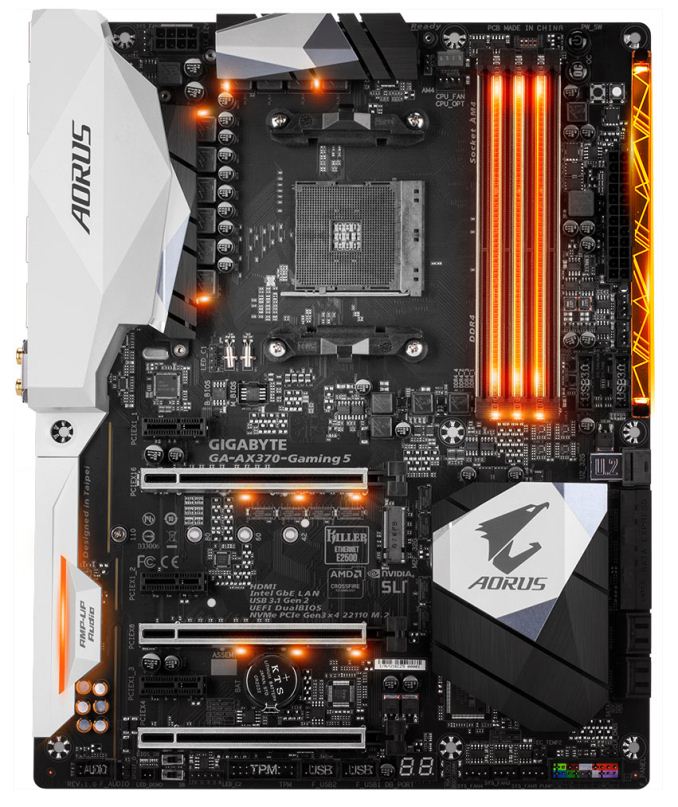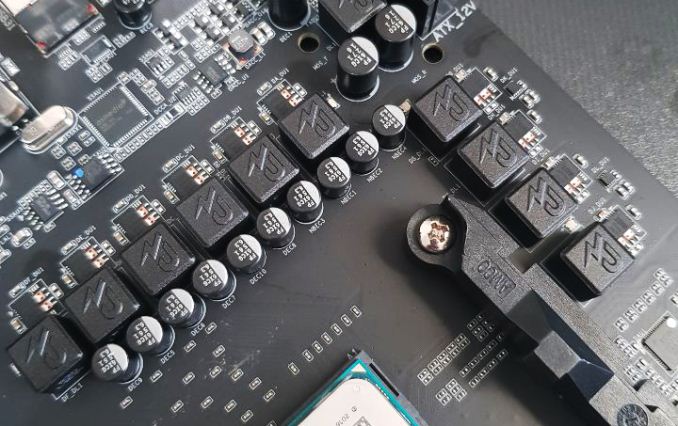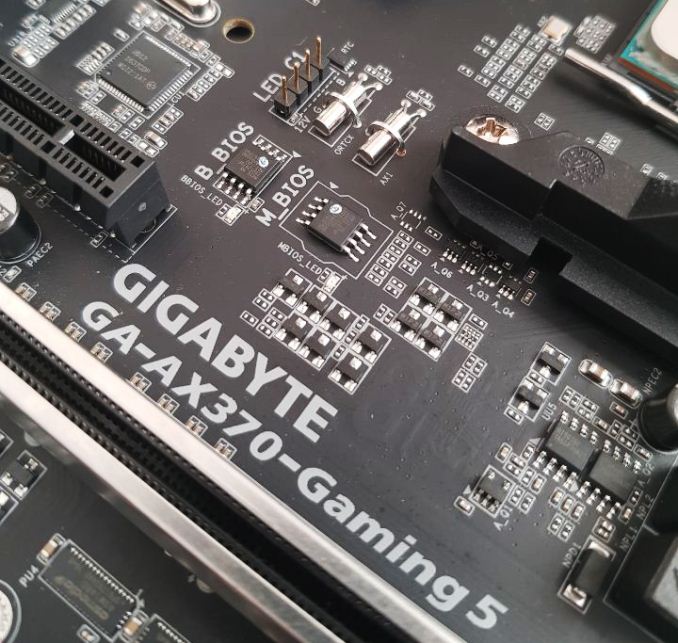The GIGABYTE Aorus AX370-Gaming 5 Review: Dual Audio Codecs
by Gavin Bonshor on November 14, 2017 12:30 PM ESTGIGABYTE Aorus AX370-Gaming 5 Board Features
The Gaming 5 has a lot about it if we factor in the high volume of connections and inputs on a sub $200 offering. Physically Gaming 5 has support for both 2-way SLI and 3-way CrossFire multi-graphics configurations, although theoretically there is support for up to 4-way SLI and 4-way CrossFire with GPUs featuring two GPU cores on a single PCB. GIGABYTE is known for emphasizing its onboard audio solutions on their range of upper-end boards, but the AX370-Gaming 5 features dual Realtek ALC1220 codecs with the second designed specifically for the front panel audio.
| GIGABYTE Aorus AX370-Gaming 5 ATX Motherboard | |
| Warranty Period | 3 Years |
| Product Page | Link |
| Price | $174 |
| Size | ATX |
| CPU Interface | AM4 |
| Chipset | AMD X370 |
| Memory Slots (DDR4) | Four DDR4 Supporting 64GB Dual Channel Up to 3200 MHz |
| Video Outputs | HDMI 1.4 |
| Network Connectivity | Killer E2500 & Intel I211-AT |
| Onboard Audio | Realtek ALC1220 |
| PCIe Slots for Graphics (from CPU) | 2 x PCIe 3.0 (x16, x8/x8) |
| PCIe Slots for Other (from PCH) | 1 x PCIe 2.0 (x4) 3 x PCIe (x1) |
| Onboard SATA | Eight, RAID 0/1/10 |
| Onboard M.2 | 1 x PCIe 3.0 x4, on Front |
| USB 3.1 (10 Gbps) | 1 x Type-C 3 x Type-A |
| USB 3.0 (5 Gbps) | 2 x Rear Panel 4 x Header |
| USB 2.0 | 4 × Header |
| Power Connectors | 1 x 24-pin ATX 1 x 8-pin CPU |
| Fan Headers | 1 x CPU (4-pin) 4 x System (4-pin) 2 x System/Pump (4-pin) |
| IO Panel | 6 x USB 3.1 (USB 3.1 Gen 1) 3 x USB 3.1 (USB 3.1 Gen 2) 1 x USB 3.1 Type-C 2 x Network RJ-45 1 x HDMI 1.4 1 x Combo PS/2 5 x 3.5 mm Audio Jacks 1 x Optical SPDIF Out Port |
Visual Inspection
The Gaming 5 has a wave of customisable RGB LED zones across multiple areas. Going from left to right, there is are subtly placed LEDs in the plastic audio component cover, and next to this are a couple of single LEDs placed at either side of the chokes in the VRM area. In the center, and under each of the two PCIe x16 3.0 slots, we get three LEDs forming a strip directly under the slots. On the right-hand side, there is an array of lighting in between the memory slots, and an LED bar on the right using a plastic pattern that can be replaced.
The top right-hand corner of the board features (what I like to call) 'a basic overclockers toolkit', and consists of a power button, a one-click OC button and small reset CMOS and system reset buttons. There also are five 4-pin PWM headers (including CPU) on the board, with two high-powered fan headers for users with water cooling pumps. The audio area has the pair of Realtek ALC1220 codecs, for both rear and front panel audio, which uses gold Japanese Nichon audio capacitors. Nippon Chemi-Con 10k solid capacitors are used elsewhere on the board and are black in colour.
Aside from the single and centrally located PCIe x4 NVMe M.2 storage slot, the rest of the storage options can be found on the lower right-hand side of the board. There are eight SATA 6Gb/s ports as well as two SATA Express ports. To the right is a single U.2 port as well.
With the power delivery, GIGABYTE is using a 10-phase digital power design. The VRM is controlled by am International Rectifier IR35201 digital PWM controller, running in 4+2 mode, with an IR3599 doubler bringing the count to 8+2. Supplementing the VRM controller, the board utilizes the International Rectifier IR3553M 40A MOSFETs and GIGABYTE's own designed ferrite core chokes.
One of the more premium features on the Gaming 5 is having a dual BIOS system. The BIOS in use can be selected via a switch on the board. At the bottom of the board just located below the bottom PCIe x16 slot are two switches which allow the user to change the configuration of the BIOS implementation: when switched into single mode, each of the two BIOS chips can run different BIOS versions (which is handy for overclockers who use different BIOS versions depending on the CPU model). When selecting the dual BIOS mode, they run in a mirror configuration; it reflects the image across both of the BIOS chips for redundancy purposes.
On the rear panel, there is single USB 3.1 Gen 2 Type-C port and single USB 3.1 Gen 2 Type-A port which are supported via the ASMedia ASM1143 USB controller. Also present is an additional two USB 3.1 Gen 2 type-A ports as well as six USB 3.0 ports and 3.5mm audio jacks for the onboard audio with S/PDIF output. A lot less emphasis has been placed on the onboard graphics as a there is only a single HDMI 1.4 output, with GIGABYTE showing its intent to market this board primarily to those planning on to use discrete graphics. There are two physical network ports, using the Rivet Networks Killer E2500 chip and the Intel I211-AT controller. Also present is a combination PS/2 port.














34 Comments
View All Comments
khanmein - Tuesday, November 14, 2017 - link
Why not using Handrake v1.0.7?PeachNCream - Tuesday, November 14, 2017 - link
That's probably so benchmark results are can be compared with previous reviews.IGTrading - Thursday, November 16, 2017 - link
Thank you for the good review.I also think there should be some USB transfer tests and LAN NIC tests as well.
Nothing too complicated, just large file transfer speeds, photo files and a set of small diverse files.
And maybe we should throw a comparable Intel setup in there, just to see how how the chipsets compare while handling the USB and LAN transfers, BOOT speeds, etc.
ayqazi - Tuesday, November 14, 2017 - link
I can't actually understand why you would have 2 audio codecs... or perhaps this is a case of "if you have to ask what it's for, you don't need it"HollyDOL - Tuesday, November 14, 2017 - link
The use cases are super rare, but still might come in handy. I use the machine as a terminal for two users (with added Aster software layer), each has own audio, so it's possible each user has complete experience, being able to use speakers or headset etc.Lord of the Bored - Tuesday, November 14, 2017 - link
Honestly, for an admittedly super-rare use case, I would just tell people "install a sound card if you want a second set of DACs". God knows there's enough slots for it.Samus - Wednesday, November 15, 2017 - link
The ridiculous thing is taking up real estate or a second Codec when one can be added via USB for $10.HollyDOL - Wednesday, November 15, 2017 - link
Actually that's exactly what I do, dedicated card plays better anyway :-)milli - Tuesday, November 14, 2017 - link
Did you read the review?One is dedicated to the back and one to the front.
If you didn't know, these audio codecs don't have the same quality output over all channels and usually the front audio quality takes a hit. Hence the dual codec arrangement.
Hixbot - Tuesday, November 14, 2017 - link
Isn't everyone these days just using digital audio output. Better to Bitstream to a quality dac, no need for on board dac, especially two of them